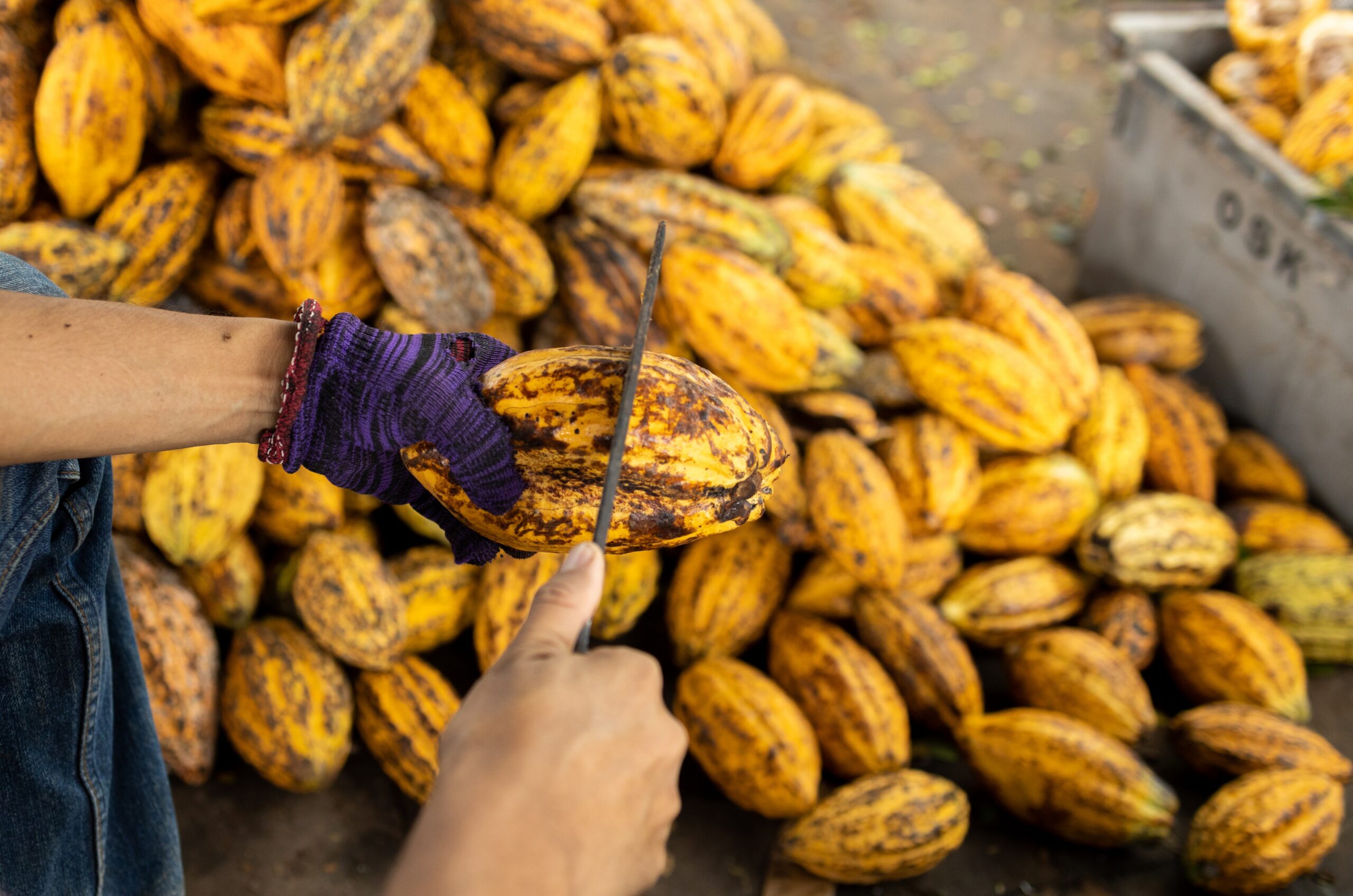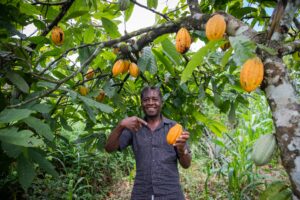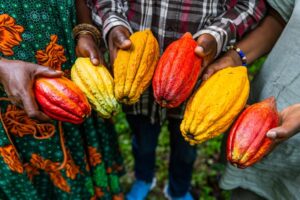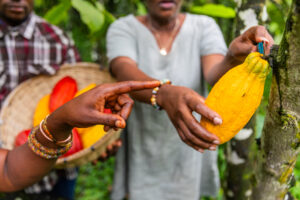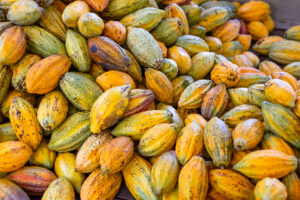Cocoa mass—often called cocoa liquor—is a fundamental ingredient in creating the rich, deep chocolate flavor we love. Despite its name, cocoa liquor contains no alcohol; it simply refers to the smooth, liquid state the mass takes when melted. This versatile paste is made by grinding roasted cocoa beans (or nibs) into a thick puree, which includes both cocoa solids and cocoa butter. It plays a crucial role in both taste and texture when it comes to making chocolate, as well as in countless applications across the food industry.
That said, let’s quickly look at some important things that will be discussed in this blog.
-
What cocoa mass is and how it’s produced
-
The difference between cocoa mass and other cocoa products
-
How is cocoa mass used in chocolate making, baking, and confectionery
-
Industrial applications and factory-scale uses
-
Trends in the UAE chocolate industry and demand for cocoa liquor UAE-wide
-
Tips for selecting cocoa paste suppliers and handling/storage best practices
-
How RADAD International supplies cocoa raw materials for all needs
What Is Cocoa Mass (Cocoa Liquor)?
Cocoa mass is the purest form of chocolate before any sweeteners or dairy ingredients are added. It’s made by grinding roasted cocoa beans until they form a thick, rich paste. The paste is made of:
-
Cocoa solids: These give chocolate its deep, bitter flavor.
-
Cocoa butter: A natural fat that adds smoothness and creaminess.
This combination makes cocoa mass the base for nearly all types of chocolate, from dark to milk to white. It’s also used in baking and fillings for pastries and desserts.
In regions like the UAE, where premium confectionery is on the rise, cocoa liquor is a highly sought-after raw ingredient for both artisanal and industrial use.
How Cocoa Liquor Is Made
Harvesting and Fermentation
Cocoa beans grow inside pods on the cocoa tree. After harvesting, beans are removed and fermented under banana leaves or in wooden boxes for several days. Fermentation is crucial—it develops the beans’ aromatic precursors and reduces bitterness.
Drying and Roasting
Once fermented, beans are sun-dried or mechanically dried to reduce moisture to about 6–7%. They’re then roasted at 120–150°C, which further develops flavor and kills bacteria.
Winnowing and Grinding
After roasting, beans are cracked and winnowed to separate nibs from shells. Nibs contain the valuable cocoa solids and butter. Nibs are ground in stone or steel grinders into a hot, liquid paste—this is your cocoa mass.
Pressing (Optional) and Liquor Blocks
Cocoa mass can be molded into blocks or pressed to extract cocoa butter, leaving a solid cake that is ground into cocoa powder. But for pure applications, the unpressed mass—rich in both fat and flavor—is used directly.
This process, whether done in artisanal micro-batch facilities or massive industrial plants, determines the mass’s flavor profile, texture, and quality.
Cocoa Mass vs. Other Cocoa Products
Understanding product grades helps you choose the right ingredient:
| Product | Composition | Use Cases |
| Cocoa Mass (Liquor) | 100% nib grind (solids + butter) | Chocolate making, fillings, rich batters |
| Cocoa Butter | Pure cocoa fat (>99% fat) | Tempering chocolate, fillings, cosmetics |
| Cocoa Powder | Pressed mass minus most butter | Baking, beverages, light chocolate flavor |
| Chocolate Couverture | Mass + sugar + butter | Professional chocolate and confectionery |
When a recipe calls for intense cocoa flavor and creamy texture, nothing beats cocoa mass.
Cocoa Powder vs. Cocoa Mass: What’s the Difference?
People often confuse cocoa powder with cocoa mass, but they are not the same.
-
Cocoa mass contains both solids and fats from the cocoa bean.
-
Cocoa powder is made by pressing cocoa mass to remove most of the fat (cocoa butter).
So while cocoa powder is great for baking and making drinks, cocoa mass is more intense and versatile. If you’re making high-quality chocolate or rich fillings, cocoa mass gives better results.
The Role of Cocoa Mass in Chocolate Making
When we talk about chocolate making cocoa, cocoa mass is the starting point. Chocolate makers use cocoa mass to develop a specific flavor profile. Here’s a simple breakdown of how cocoa mass is used in chocolate:
Dark Chocolate
Dark chocolate recipes start with 100% cocoa mass. Sugar and sometimes vanilla are added. By varying sugar ratios and mass origin, you control bitterness, sweetness, and flavor nuances.
Milk Chocolate
Cocoa mass is blended with milk powder, sugar, and extra cocoa butter. The ratio of mass to butter affects creaminess; higher mass content delivers a stronger cocoa punch.
White Chocolate
Chemically, white chocolate contains no cocoa solids but relies on cocoa butter (extracted from mass). Knowing mass origin helps guarantee pure, high-quality butter.
Flavor Development
Single-origin cocoa liquor—sourced from places like Ghana, Ecuador, or Madagascar—imparts unique tasting notes (fruity, nutty, earthy). Artisanal chocolate makers often list bean origins on bars to highlight flavor.
The percentage you see on chocolate packaging (e.g., 70%) usually refers to the proportion of cocoa mass (or a mix of mass and butter) in the final product. A higher percentage means a stronger, more intense cocoa flavor.
With the chocolate industry growing in the UAE, especially in Dubai, many local and international brands are turning to high-quality cocoa liquor to craft premium chocolate products.
Cocoa Mass in Baking and Pastry
Cakes and Brownies
Replacing some cocoa powder with melted cocoa mass in cake or brownie batter deepens chocolate flavor, adds moistness, and enhances texture.
Fillings and Ganaches
Ganache is a simple mix of cocoa mass and cream (ganache = gana + che). Ratios determine consistency: 2:1 cocoa mass to cream for truffle centers, 1:1 for cake fillings.
Pastries and Confections
Cocoa for fillings goes beyond ganache: from chocolate mousses to layered tarts. Mass gives a professional sheen and mouthfeel that powdered cocoa can’t match.
Cocoa Mass for Cakes, Fillings, and Pastries
Cocoa mass is not just for chocolate bars. It’s also widely used in baking, especially for:
-
Cakes: Adding cocoa mass to cake batter gives it a richer, deeper flavor than cocoa powder alone.
-
Fillings: It creates smooth, indulgent fillings for truffles, tarts, or layered desserts.
-
Pastries: From pain au chocolat to choco croissants, cocoa mass is often used for its intensity and texture.
Many pastry chefs prefer cocoa mass over cocoa powder because it delivers more flavor and better mouthfeel. That’s why cocoa for fillings, cocoa for pastries, and other similar ingredients are gaining popularity in professional kitchens and industrial bakeries alike.
Industrial Cocoa Use in the UAE and Beyond
Across the UAE, there’s growing demand for cocoa mass, especially in food manufacturing. From chocolate factories to commercial bakeries, cocoa mass is a vital ingredient.
Dubai, in particular, is becoming a hub for gourmet and luxury food. You’ll find many chocolate manufacturers in the region sourcing premium cocoa liquor widely to meet rising consumer expectations.
Large factories use cocoa mass in:
-
Chocolate production
-
Ice cream and frozen desserts
-
Cereal and snack bars
-
Premium confectionery and baked goods
As demand increases, so does the need for reliable cocoa paste suppliers that offer high-quality, bulk products for factories and food companies.
Trends in the UAE Chocolate Industry
Dubai and the broader UAE market show strong demand for:
-
Premium Bean-to-Bar: Small-batch makers emphasize origin and craft production.
-
Functional Chocolates: Infused with superfoods, protein, or adaptogens.
-
Fusion Flavors: Local ingredients—dates, saffron, cardamom—mixed with cocoa mass.
-
Sustainable Sourcing: Ethical, fair-trade single-origin liquor.
-
Artisanal Experiences: Workshops, tastings, chocolate tourism.
With tourists and residents always seeking new gourmet experiences, many chefs and manufacturers in the UAE choose top-grade cocoa mass to stay ahead in the game.
Selecting a Cocoa Paste Supplier
When evaluating suppliers, consider:
-
Purity & Consistency: 100% unadulterated cocoa mass.
-
Origin Transparency: Single-origin options for unique flavors.
-
Food Safety Standards: ISO, HACCP, and local certifications.
-
Packaging & Logistics: Bulk or custom packaging, shelf-stable handling.
-
Technical Support: Product specs, melting points, application guidance.
In the UAE, RADAD International is known for supplying high-grade cocoa mass, backed by reliable delivery and technical expertise.
Storage and Handling Best Practices
-
Temperature: Store between 18–22°C to prevent viscosity changes.
-
Humidity: Keep under 50% to avoid sugar bloom.
-
Light Exposure: Avoid direct sunlight—UV can degrade flavor.
-
Airtight Containers: Prevent oxidation and odor absorption.
-
First-In, First-Out: Use older stock first to maintain freshness.
Where to Source Quality Cocoa Mass
Finding a trusted supplier for your cocoa needs is key, especially if you’re in the food business. Whether you need cocoa for factories, cocoa for pastries, or cocoa liquor in bulk, you need quality, consistency, and good supply terms.
RADAD International is one of the reliable names in the industry, supplying a range of cocoa raw materials across the UAE and beyond. From raw cocoa beans and nibs to cocoa mass, RADAD supports both small businesses and large factories with premium products tailored for chocolate making, baking, and industrial use.
Frequently Asked Questions (FAQs)
-
What is cocoa mass made of? Cocoa mass is made by grinding roasted cocoa nibs into a thick paste that contains cocoa solids and cocoa butter.
-
Is cocoa liquor the same as cocoa mass? Yes, the terms are used interchangeably. There is no alcohol in cocoa liquor; it’s just a technical term.
-
Can I use cocoa powder instead of cocoa mass? Not always. Cocoa powder lacks the fat and depth of flavor found in cocoa mass, so it’s better to use cocoa mass when possible in chocolates and rich fillings.
-
Where can I find cocoa paste suppliers in the UAE? RADAD International is a trusted name offering various cocoa ingredients, including cocoa paste and cocoa liquor.
-
Why is cocoa mass used in baking? Because it adds deeper flavor and a richer texture compared to cocoa powder, making cakes, pastries, and fillings more indulgent.
-
Is cocoa mass suitable for all kinds of chocolate? Yes, it is the base ingredient for dark, milk, and even flavored chocolates.
-
Is cocoa mass healthy? In moderation, yes. It contains antioxidants and less sugar than processed chocolate.
-
Does RADAD supply cocoa for industrial chocolate use? Yes. RADAD provides cocoa products in bulk for industrial use, including factories and commercial chocolate makers.
-
How long does cocoa liquor last? Properly stored, it can last 2 years. Fat oxidation is the main concern.
-
What’s the difference between cocoa paste and cocoa mass? They are the same—different industry terms for ground cocoa nibs in paste form.
-
What’s the benefit of single-origin cocoa mass? Unique terroir-driven flavor notes—fruity, nutty, floral—that standard bulk mass lacks.
-
Can cocoa mass be used in savory dishes? Yes—mole sauces, cocoa-rubbed meats, and rich chili dishes use small amounts for depth.
About RADAD International
RADAD International is a leading provider of cocoa raw materials, supplying cocoa beans, cocoa nibs, cocoa mass, cocoa butter, and more. Whether you’re a boutique chocolatier or an industrial factory, RADAD offers quality cocoa products tailored to your needs. If you’re looking to elevate your chocolate or pastry products, starting with high-quality cocoa mass is a great first step. Contact RADAD International today for premium cocoa supplies tailored to your business needs in the UAE and beyond.


